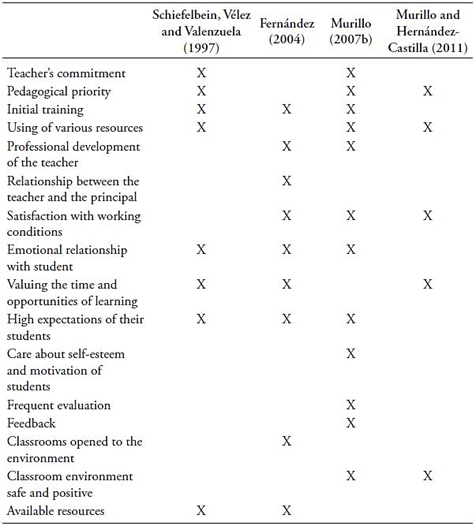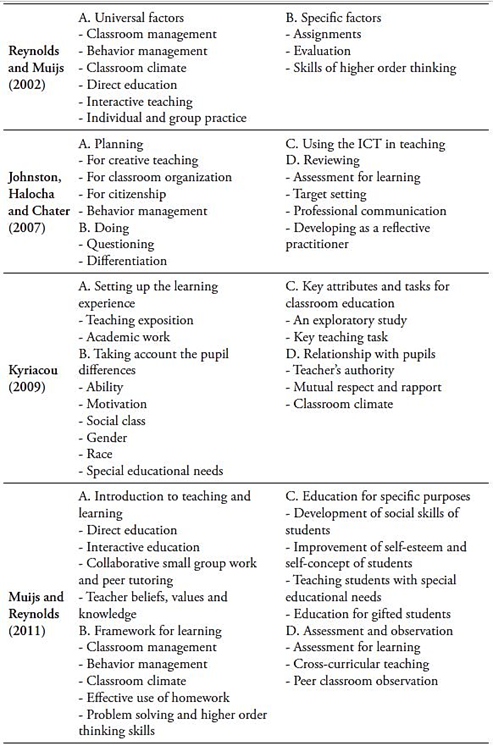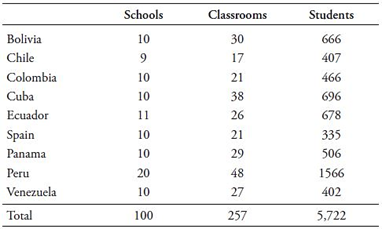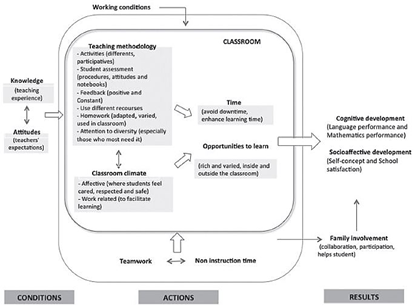1. Introduction
During the last decade, the importance of Educational Effectiveness Research, (EER), has been well recognized throughout the developed world. Unfortunately, most of the EER models proposed so far, focus almost exclusively on a small number of countries with very specific characteristics of education, economy, and culture. These EER outcomes, however, were considered valid for the elaboration of recommended policies applied in other countries. Unfortunately, EER results can only be accurately applied to socioeconomic contexts with great similarity to the one they were obtained from and, therefore, only extrapolated to countries with similar education systems.
The scarcity of the information necessary to elaborate an EER model for the Ibero-American countries made it impossible for these countries to benefit from accurate research on effective teaching, until now (Murillo, 2007a; Reynolds et al., 2016).
Research and experience have shown that the activities taking place inside the classroom are elements that have a strong influence on the academic development of students. Thus, depending on the pedagogical principles and the practices involved in the classroom, the behaviors and attitudes of the teachers, or even work atmosphere during class, (to cite a few examples), the performance of the students will vary. Teaching Effectiveness Research (TER) focuses on identifying the factors in the classroom that are more effective in influencing the appropriate development of students, to improve the quality of education (Campbell et al., 2012; Creemers, 1994; Walker, 2008).
This research, focused on both the classroom and the teacher, complements a previous study that sought to identify the school factors that make a school effective (Martínez-Garrido, 2012). This research analyzes the findings of EER from the main international studies and through an in-depth study of selected EER from different regions, that vary in terms of the educational model. Here, a presentation is made of a study on effective teaching, using a Multilevel Model that identifies the factors for effective teaching. Also presented is a new model developed to guarantee effective teaching in the classrooms of Ibero-American countries.
2. Literature Review
It is understood that Effective Teaching is: “the set of actions that a teacher takes in order to promote the personal and academic development of all of his/her students” (Martínez-Garrido, 2015). These actions take into account the previous performance of the student, as well as the social, economic, and cultural situation of their families. The following elements are identified in this definition:
Improvement of the comprehensive development of the student, emphasizing that both socio-affective and cognitive (and psychomotor) development are important.
Equity among the students, due to the fact that teaching will only be effective if it promotes the development of all the students.
Long-term beneficial effects: Effective teaching tries to produce beneficial impacts on the students in the long term, in addition to the immediate short-term benefits.
Added value. Effective teaching is not measured by learning; it is measured by the amount of learning enabled by the work of a teacher in the classroom.
From this definition, and from the perspective of this research, effectiveness, (the development of every student in the classroom), is a necessary condition but, by itself, it is not enough to meet the challenge of achieving educational quality. It is also necessary that the teaching style promotes critical thinking, supports diversity among the students, and promotes democratic decision-making. The teaching style promoted by the school has to consider teachers as critical intellectuals and focus on the training of students as ‘agents of social change’ (Smyth, 2011).
Early studies on effective teaching can be dated around the 30s of the past century. It is possible to group all the thousands of research, being developed during these 85 years, into three large stages, according to the subject and the methodology used, rather than according to strict time lines:
Stage 1. Ideal teacher (1930-1960). Notable works of Charters and Waples (1929), Cattell (1931), Witty (1947) or Highet (1950). The aim of these early works was to identify the ideal attributes or traits of effective teachers. These studies established a ranking and a set of global parameters to quantify the talent of the teachers. For example, Charters and Waples (1929) proposed 25 features that an ideal teacher should have: adaptability, consideration, enthusiasm, good judgment, honesty, magnetism etc.… Highet (1950) indicates, “what makes a good teacher is to know how to communicate” (p. 97). The main question discussed at this stage is: “Are good teachers born or made?”. The final conclusion extracted was that there is not a unique personal characteristic what makes a teacher effective.
Stage 2. Behaviours of the teacher (1960-1980). Having failed to find how effective teachers are, the studies on effective teaching focused on understanding what effective teachers do-trying to determine their behaviour. Therefore, during the beginning of the 60s Taylor (1962) indicated some of these behaviours: teachers are firm and maintain order in the classroom, they are also fair with the use of punishment and explain the learning activities to help the student. Effective teachers were also found to be friendly with their students. During these two decades, researchers were searching for the best teaching methodology, in an attempt to help the students to learn more. Nowadays, we know that there is not only one entelechy. Interesting contributions to this stage are represented by Carroll (1963), Rosenshine (1971), Hughes (1973), or Good and Grouws (1979).
Stage 3. Studies on Educational Effectiveness. From the early 80s, School Effectiveness Research discovered that what happens in the classroom is what influences the development of students the most. Since then, the Effective Teaching Research has been merged with the School Effectiveness Research, forming Educational Effectiveness Research. During this stage, one should highlight the works of Brophy and Good (1986), Mortimore, Sammons, Stoll, Lewis, and Ecob (1988), Creemers (1994), Scheerens and Bosker, 1997; Opdenakker and Van Damme (2000), Van Petegem, Creemers, Aelterman, and Rosseel (2008), Murillo and Martínez-Garrido (2014) or Muijs et al. (2014). As has been mentioned, Stage 3 introduces a new global approach with two main features: i) The link between the classroom and school. ii) The fact that the outcome of learning is not only academic achievement, but also socio-affective development.
There are few studies on effective teaching in Ibero-America, so it is uncertain whether there are existing factors of effective teaching at this stage. Particularly noteworthy research has been conducted in Argentina, Chile and Perú; for example, Cervini (2002, 2003), Cueto (2003), Martinic and Pardo (2003). Some reviews about the research on school effectiveness developed during the last period of the stages detailed above, provided some useful information about what those features were for Ibero-American schools (Fernández, 2004; Murillo, 2007b; Schiefelbein, Vélez, & Valenzuela, 1997). Table 1 summarizes the findings of each study, and includes those, contributed by Murillo and Hernández-Castilla (2011) that was considered to be the first study addressing impact on the socio-emotional development of the students in Ibero-America.
After reviewing the different studies conducted worldwide during the last 85 years, this research developed a list of factors as “lessons learned” from effective schools. The interpretation of these factors, and their ranking in relevance are summarized in the following Table (Table 2).
From the existing bibliography about effective schools, ten main factors capable of enhancing effective learning could be outlined (Murillo, Martínez-Garrido, & Hernández-Castilla, 2011, p. 19):
i. Involvement and commitment of the teacher.
ii. Classroom atmosphere.
iii. High expectations and self-confidence.
iv. Structured lessons.
v. Varied and participatory activities.
vi. Attention to diversity.
vii. Optimization of learning time.
viii. Classroom organization and management.
ix. Use of educational resources.
x. Educational assessment, monitoring, and continuous feedback.
Previous research on Educational Effectiveness had not only proposed a list of factors linked to effective teaching; it had also developed models that included both: what is already known, and hypotheses about effective teaching. For example, the model proposed by Dunkin and Biddle (1975) reflects the link between learning results and behaviors of the teacher and the student. Similarly, the five-factor model by Edmonds (1979) or the more popularly known model by Creemers (1994) built on four formal criteria: coherence, cohesion, consistency, and control. In 2009, Creemers along with Kyriakides and Antoniou conducted an empirical test of his own model, proposed in 1994. This test served to develop an improved model called “the Dynamic Model of Educational Effectiveness” where each factor was defined and measured through five dimensions (frequency, focus, stage, quality, and differentiation) (Kyriakides, Creemers, & Antoniou, 2009).
In this research a theoretical model is built on the basis of the factors discovered by the International and Ibero-American research. This theoretical model has three characteristics: i) it focuses on development of the student in the classroom; ii) it defines the levels of the educational system in terms of their contribution or impact on the classroom processes and, iii) it recognizes and sets out the characteristics, values, and knowledge of the teacher, (as well as the educational, political, and social context of the school, see Figure 1).
The model developed in this research focuses on finding an answer to the following research question: What are the differences between the processes of effective teaching in Ibero-America and those described in the International literature? The main objectives of this research were to identify the factors that make teaching effective and to determine their impact. The aim was also to develop an Ibero-American Model of Effective Teaching.
The overarching aim was to develop a set of intervention models that could contribute to the improvement of education through an optimization of the processes of teaching and learning
3. Methodology
This research complements a previous study called “Ibero-American School Effectiveness Research (ISER)” (Murillo, 2007a). The school effectiveness research with the greatest impact and improvement of quality conducted in Ibero-America is called ISER. ISER is an international study performed by nine research teams from selected countries and designed to meet all the methodological demands of research on school effectiveness. The main characteristics of this model are: i) the use of a preliminary theoretical framework that guides the design of the work; ii) the consideration of the variables «cognitive» and «socio-affective development of the student» as a product; iii) the “added value approach”, that considers the measurements of previous performance (collected at the beginning of the school year); iv) the use of a multilevel approach with four levels of analysis (student, classroom, school, and country); v) the use of a large and properly selected sample and a wide variety of instruments validated in each country.
Much of the statistical data collected by the ISER, however, has not been fully analyzed, and the information about the classroom has yet to be studied. This research addresses this deficiency by focusing attention on the classroom.
After a long process of sorting, configuration, and scaling, the large number of variables obtained by the ISER have been reduced to four product variables (two of cognitive development and two of socio-affective development), 11 adjustment variables, and 61 explanatory variables (Table 3).
Table 3 Variables of the study
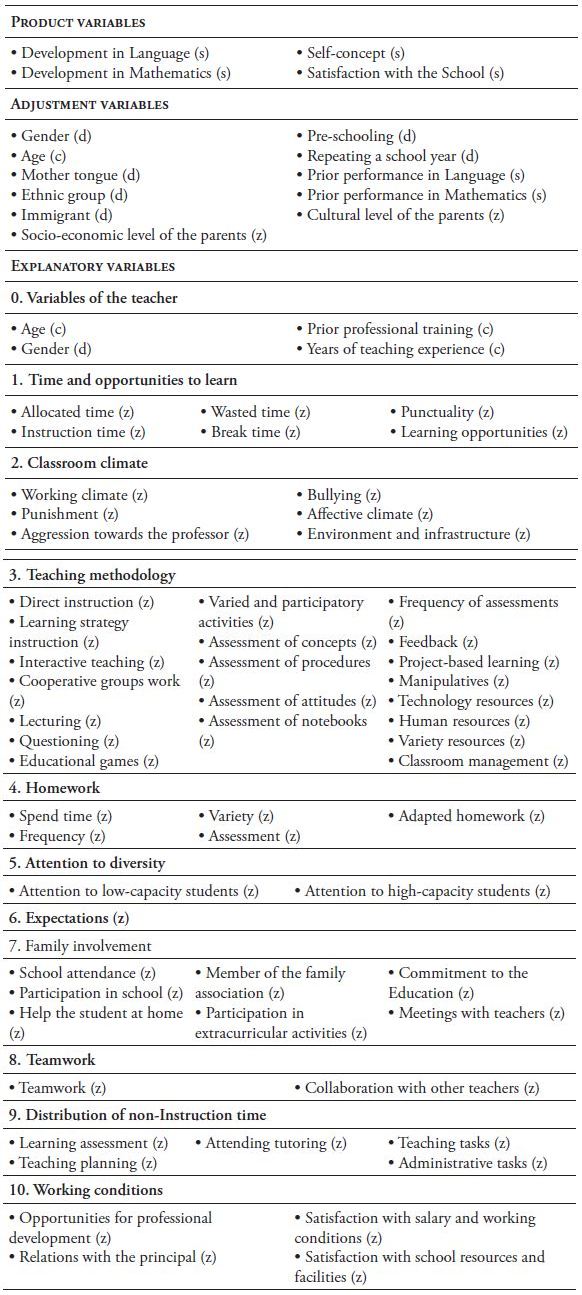
Note: (s) variable with Mean 250 and SD 50; (d) dummy variable; c) variable centering by mode; (z) standardized variable. Elaborated by the authors.
3.1. Sample and Sampling
The sample consisted of 5,722 students from 257 classrooms from the third year of Primary School, attending 100 schools located in 9 countries of Ibero-America (Bolivia, Chile, Colombia, Cuba, Ecuador, Panama, Peru, Spain, and Venezuela) (Table 4). The sample was selected so that it would be possible to verify whether previous EER studies were generalizable, once the variables related to the classroom were taken into account. The approach was to select certain cases, in the way that: a) they fulfilled the methodological requirements of the research (for example, different cases from each level were organized hierarchically); b) they worked with maximum experimental variability (for most of the countries in the study, half of the schools could be considered below the average, when talking about effective teaching according to the opinion of the Inspectors); c) the schools were also representative of different kinds of neighborhoods in the country (they were chosen from different large and medium cities as well as villages from regions all over the country). The introduction of data coming from countries of South America, Central America, the Caribbean, and Europe, as well as the diversity of the social, economic and educational status of the nine countries involved, enabled the researchers to assert that the model elaborated from this sample, would closely approximate the reality of the Ibero-American community as a whole.
3.2. Instruments
Nine instruments were used to obtain the information in the model:
Achievement tests: Two equivalent tests of Achievement in Mathematics, and two equivalent tests of Achievement in Language. Each test served to measure the previous and final achievement in each subject. The Latin American Laboratory for the Assessment of Quality of Education, from UNESCO, developed the tests for the First Comparative and Explanatory Study. Each of the two tests on Mathematics are composed of 31 multiple-choice questions with four multiple-choice alternatives. The reliability alpha coefficient for test A (previous achievement) was 0.890, and 0.895 for the test B (final achievement). The two tests of Achievement in Language include 19 questions with four multiple-choice alternatives, and one open final question. The alpha coefficient was 0.923 for test A, and 0.925 for test B.
Self-concept test: This test was elaborated from the Self-Description Questionnaire (Marsh, Craven, & Debus, 1991). This test consists of 56 Likert-type questions with four multiple choice answers. The Self-concept test provides information about the academic, non-academic, and general Self-concept of the student. The reliability was estimated as α=0.938.
Questionnaires: Four different questionnaires were developed and used, targeting different school groups: one for students (general questionnaire for students), another for their families (questionnaire for families), a third for teachers in selected classrooms (questionnaire for classroom teachers), and a final questionnaire for the teachers of the school (Questionnaire for school teachers). These four questionnaires provided information about personal characteristics of the students and their families, characteristics of the school, and more than a hundred questions related to the teachers, such as: their personal characteristics, the way they teach their students etc.
3.3. Data analysis
Multilevel Analysis was used with four levels of analysis (country, school, classroom, and student) to study the impact of the potential factors of Effective Teaching resulting in student development (cognitive and socio-affective). Because the students in the data sample were nested within classrooms, schools, and countries, hierarchical linear modeling was used. Hierarchical linear modeling was used to address problems specific to nested or multilevel data (Dempster, Laird, & Rubin, 1977; Raudenbush & Bryk, 2002). Multilevel analysis is especially suited for investigations of contextual effects because it allows researchers to disentangle the compositional or group-level effects of student background characteristics, from individual effects (Creemers, Kyriakides, & Sammons, 2010; Goldstein, 2011; Martínez-Garrido & Murillo, 2013). The product variables were calculated using the following procedure:
i. Estimate the null model (Model I), using only the product variable;
ii. Re-calculate the model adding ten adjustment variables (Model II);
iii. Include in the adjusted model, one variable at a time, each of the four variables of teachers and the 57 variables related to the effective teaching factors (Model III).
iv. Estimate the final model using only those explanatory variables that make a significant contribution to the model for each product variable (Model IV).
Four multilevel models were estimated, one for each product variable. All of them were analogous to the following:
Y ijkl = β 0jkl + β 1jkl NSE ijkl + β 2jkl NCult ijkl + β 3jkl Gender ijkl + β 4jkl Age ijkl
+ β 5jkl Mother_tongue ijk
+ β 6jkl Ethnic ijkl + β 7jkl Inmigrant ijkl + β 8jkl Preesch ijkl + β 9jkl Repeating ijkl +
β 10jkl Prior_perform ijkl + β 11kl Teach_age jkl + β 12kl Teach_gender jkl +
+ β 13kl Teach_training jkl + β 14kl Teach_Experien jkl + β 15kl Var1_Effec_Teach jkl … +
+ β 71kl Var57_Effec_Teach jkl + e ijkl
β 0jkl = β 0 + f ol + ν okl + u 0jkl
β 1jkl = β 1 + f 1l + ν 1kl + u 1jkl … β 10jkl = β 10 + f 10l + ν 10kl + u 10jkl
β 11kl = β 11 + f 11l + ν 11kl … β 71kl = β 71 + f 71l + ν 71kl
with
[e 0ijkl ] ~ N(0,Ω ε ): Ω ε = [σ 2e0 ]
[u 0ijkl ] ~ N(0, Ω μ ): Ω ε = [σ2u0]
[ν 0ijkl ] ~ N(0, Ω ν ): Ω ν = [σ2 ν 0 ]
[f 0ijkl ] ~ N(0, Ω f ): Ωφ = [σ2f0]
where
y ijkl , are different measures of student achievement: Achievement in Mathematics, Achievement in Language, Self-concept, and Satisfaction with the School.
VarN_Effec_Teach jkl , refers to the 57 variables of teaching effectiveness arranged into 10 factors. The study of these variables seeks to validate this theoretical model developing an empirical model of effective teaching for Ibero-America.
4. Results
Consistent with the objectives of this research, the results were organized into two independent sections: i) the study of the impact of the factors of Effective Teaching on the cognitive and socio-affective achievement of the student; ii) the study of the Effective Teaching model for Ibero-America.
4.1. Effective Teaching Factors
The first goal of the study was to identify the factors of effective teaching that influence the cognitive and socio-affective development of the students. To quantify the influence of each factor that promotes effective teaching, the influence of prior achievements was removed and the rest of the adjustment variables. The process of multilevel modeling for cognitive development (Achievement in Language, and in Mathematics) showed that 24 of the 57 analyzed variables made a significant contribution to the models using adjustment variables (Table 5). The multilevel analysis also showed the variance explained by each level of analysis. Model II explained almost 30% of the total variance of student achievement in each outcome, and most of the explained variance was at the student level. The final model explained approximately 33% of the total variance of student achievement in Language and 35% in Mathematics. The data indicated that:
Time and opportunities to learn. The variables «instruction time» and «learning opportunities» made significant contributions to the adjusted models (cognitive product). It is possible to distinguish the high value of the instruction time coefficient in the final model, up to 15 points in Achievement in Mathematics1. The «instruction time» variable was the variable that most influenced cognitive development.
Classroom atmosphere. The “emotional climate in the classroom” and the «working environment» were the variables that improved the cognitive development of the students. A positively affective atmosphere in the classroom, generated a greater impact on Language achievement (2.2 points), while the working environment in the classroom had more impact on Mathematics achievement (3.2 points).
Teaching methodology. The six variables that made a significant contribution to Model III, both in Achievement in Language and in Mathematics, were the following: “Varied and participatory activities”, “assessment of procedures”, “assessment of attitudes”, “assessment of notebooks”, «feedback and use of different resources”. All of them made a positive contribution, but with no major differences in Language and Mathematics.
Homework. The achievement in Mathematics improved by 3 points per each standard deviation that increased the “homework assignments for students”. The achievement in Language improved by 1.8 points per each standard deviation that increased the «evaluation of homework in the classroom».
Attention to diversity. The “individualized attention to students”, particularly to those who have the most difficulties, is a factor that impacted on the cognitive development of the students, especially on their achievement in Mathematics (almost 2 points).
Expectations. Expectations of success that the teacher had towards his/her students impacted on cognitive development. Specifically, the development in Language improved by 2.3 points per each standard deviation that increased the «expectations towards the student», and almost by 4 points of achievement in Mathematics.
Family involvement. The “teacher-family collaboration” was a factor of effective teaching. The active participation of families in the classroom, their collaboration with the teacher, and the “commitment” they had regarding the education of their children, were variables that made a significant contribution to the models of cognitive achievement (2.1 and 2.5 points, respectively).
Distribution of non-instruction time. The use of the “non-instruction time of the teacher to tasks related to teaching” (such as preparing exams, lessons, attention to students, their families…) influenced the cognitive development of students. Consistently, the time spent on «administrative tasks» had a negative effect on the achievement of the student (minus 3 points).
The study has also found that teamwork among teachers and professional development opportunities were variables that contributed significantly to cognitive development. However, while teamwork mostly impacted the achievement in Language (3.5 points), the impact of professional development opportunities had the most effect on the model of achievement in Mathematics (6.4 points).
Table 5 Modeling process for product variables of cognitive development
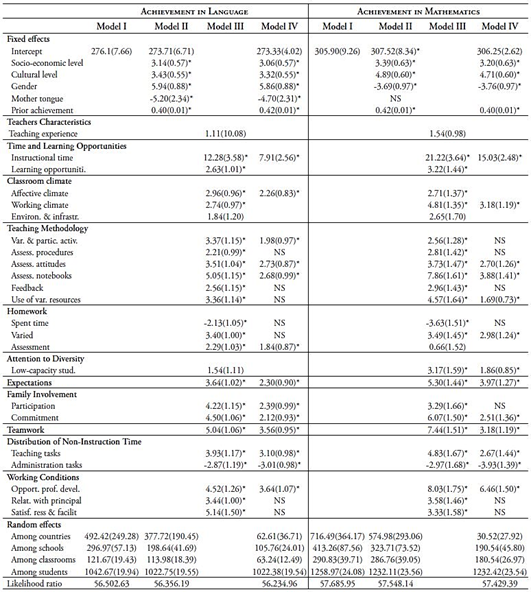
Variables that do not have statistically significant contribution and that, therefore, are not shown in the table: Age of the teacher, Gender of the teacher, Prior professional training, Allocated time, Wasted time, Break time, Punctuality, Punishment, Aggression towards the teacher, Bullying, Direct instruction, Learning strategy instruction, Cooperative groups work, Interactive teaching, Lecturing, Questioning, Educational games, Assessment of concepts, Frequency of assessment, Project-based learning, Manipulative, Human resources, Classroom management, Frequency of homework, Adapted homework, Attention to high-capacities students, School attendance of the family, Help the student at home, Member of the family association, Participation in extracurricular activities, Meetings with teachers, Collaboration with other teachers, Learning assessment, Teaching planning, Attending tutoring, Salary and working conditions. Notes: * p<0.05; NS Not significant at α=0.05.
There were a small number of variables that made a statistically significant contribution to Models III and IV considering the two measures of socio-affective development (15 variables). This demonstrated the lower incidence that teaching had on the Self-concept of the student, and their Satisfaction with the School (Table 6).
Time and opportunities to learn. “Teaching time” was the individual variable with the highest coefficient in Model IV for Self-concept (8 points). The Satisfaction at the learning center was significantly affected in Model III by «instruction time» and «learning opportunities».
Classroom atmosphere. Interestingly, neither «emotional climate» nor «working environment» in the classroom made significant contributions in Model III for either of the two variables of socio-affective development. Only the variable related to “environment and infrastructure” of the school and of the classroom appeared to be related to the Satisfaction of the student with the Centre (2.4 points).
Teaching methodology. The results indicated that «teaching methodology” seemed to have no relation either to the development of the Self-concept, or Satisfaction. There were two exceptions related to “learning assessment”: students are developing a greater (an improved) Self-concept and had greater Satisfaction with their School, if the teacher “assessed the attitudes routinely. The students also developed a greater Satisfaction with their School if the teacher «assessed their notebooks”.
Homework. Homework was associated with the Satisfaction of students and with their Self-concept. For every standard deviation that increased the design of “varied assignments”, the Self-concept of students improved by 3.8 points. The variable of “adapted homework” also made a significant contribution to the Model of the Self-concept (3 points) and almost 2 points for the final Model of Satisfaction with the School.
Attention to diversity. The variable of “attention to students with additional needs” made a significant contribution to the final Model of the Satisfaction with the School (2.7 points).
Expectations. The fact that teachers have «expectations of success» regarding the student made the student happier with the school. Specifically, 3.1 points improvement for each standard deviation.
Table 6 Modeling process for product variables of socio-emotional development
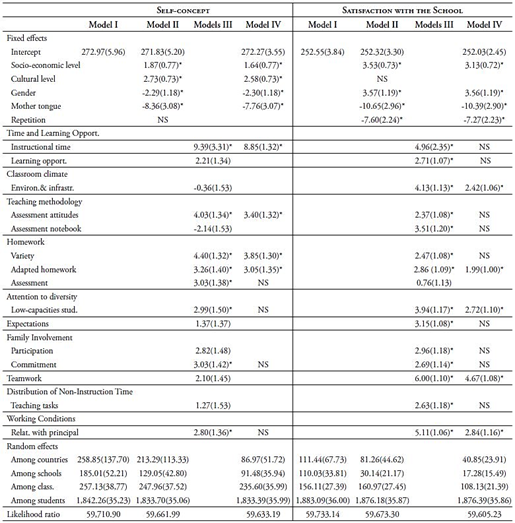
Variables that do not have statistically significant contribution and that, therefore, are not shown in the table: Age of the teacher, Gender of the teacher, Prior professional training, Years of teaching experience, Allocated time, Wasted time, Break time, Punctuality, Working climate, Punishment, Aggression towards the teacher, Bullying, Affective climate, Direct instruction, Learning strategy instruction, Interactive teaching, Cooperative groups work, Lecturing, Questioning, Educational games, Varied and participatory activities, Assessment of concepts, Assessment of procedures, Frequency of assessments, Feedback, Project-based learning, Manipulative, Technology resources, Human resources, Variety of resources, Classroom management, Spend time on homework, Frequency of homework, Attention to high-capacity students, School attendance of the family, Help the student at home, Member of the family association, Participation in extracurricular activities, Meetings with teachers, Collaboration with other teachers, Learning assessment, Teaching planning, Attending tutoring, Administrative tasks, Opportunities for professional development, Salary and working conditions, Satisfaction with the school resources and facilities. Notes: * p<0.05; NS Not significant at α= 0.05.
Family involvement. The variables of “participation of parents” and their «commitment to the education of their children» significantly impacted on Model III of Socio-Emotional Development (by 3 points for each variable and model). This demonstrated its importance in the development of a Positive Self-concept of the students and also in their Satisfaction with the School.
Distribution of non-instruction time. Students seemed to be more satisfied with the school if the teacher spent more “time on tasks related to teaching”. This variable made a significant contribution to Model III for Satisfaction towards the School by 2.6 points.
Similarly, the data indicated that the “professional experience” of the teacher and their “relationship with the principal of the school”, made a significant contribution to Model III for Self-concept (3.8 points, and 2.8 respectively). The variables of «teamwork between teachers», and the “relationship of the teacher with the school principal” made contributions to Model III of the Satisfaction of the students with the School (and in the case of “teamwork” to Model IV).
4.2. Effective Teaching Model for Ibero-America
The second aim of this study was to develop an empirically validated model of effective teaching for Ibero-America. The previous results were used to build an effective teaching model for Ibero-America.
According to the calculations of this research, ten factors of effective teaching are associated with the development of students, either with their cognitive development (Achievement in Language and in Mathematics), or with their socio-affective development (Self-concept and Satisfaction with the School), and, in most cases, with both (Table 7).
The development of an Effective Teaching model for Ibero-America is represented by a graphical depiction of the ten factors discovered in this research. The relationships between different factors are represented in a simple, visual, and global way. The factors are organized in three dimensions: the previous conditions of teachers, teaching actions, and teaching results. The actions carried out by teachers have been separated into those that happen inside the classroom, and actions that happen in other parts of the school. Figure 2 presents the model.
Table 7 Significant contributions of Teaching Effectiveness factors to the Achievement in Language, in Mathematics, Self-concept and Satisfaction with School
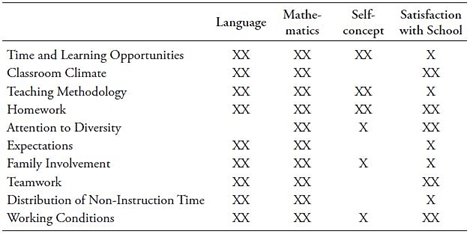
The organization of the variables are highlighted in this model. The first step was to find the variables that characterize the conditions prior to the teaching environment. Specifically, the Knowledge and the Attitudes of teachers, i.e. their experience as a teacher, and their previous expectations towards the students.
The second block of variables, include the actions of the teacher inside and outside the classroom. The factors of effective teaching occurring inside the classroom are: Teaching methodology (understood in a wide sense that also addresses the use of homework, and attention to the diversity of the students), and the Classroom atmosphere. The interaction of both factors directly influences how the Instruction time and Learning opportunities are distributed.
Finally, “other factors” are those influential variables outside the classroom that tend to promote effective actions to be taken by the teacher in the classroom. As “other factors” also included were other influential variables such as, Non-instruction time in tasks related to teaching and Teamwork activities.
The model shows the results of the teaching process including those factors directly related to the work of the teacher and the cognitive and socio-affective development of students. The model also includes the involvement of families as a result of the actions taken by the teacher in the school and as a process that influences the development achieved by students.
5. Conclusions
This research has analyzed the impact of the factors of Effective teaching on student achievement and has developed an effective teaching model for Ibero-America. According to the findings, effective teaching in Ibero-American schools is characterized by:
i. Having proper management of time in the classroom, that allows for the maximum benefit from effective time allocation for teaching and learning. According to the results, not only the amount of time is important, it is also necessary that it be quality time, (without interruptions, without wasting of time, with no distractions...). The data showed that it is important to provide learning opportunities for students.
ii. The classroom atmosphere is a fundamental factor for effective teaching. The existence of good relationships between the teacher and the students, and among the students is essential to allow the student to develop cognitive and socio-affective aspects. The research results confirm the importance of creating a classroom atmosphere where the teacher explicitly communicates high expectations to the students. A classroom atmosphere without any conflicts, where concentration and active listening dominate, where the students feel respected and taken care of, and that promotes learning and facilitates the positive use of time, helps the teacher to manage their lessons successfully.
-
iii. Five elements characterize a teaching methodology that promotes the development of the students:
a. The learning activities should be varied, participatory, and active. Far from finding one best methodology over another, the results showed that the teacher needs to perform as many varied learning activities as possible. The activities should encourage the student to interact with their peers and with the teacher. The learning activities should also promote the active learning and active listening of the students.
b. The use of resources, whether traditional or ICT, promotes the development of students. According to the research results, teachers should use different resources during their lessons.
c. Homework is a pedagogical tool available to every teacher. The homework has to be adjusted to the needs and the potential of each student in the classroom. The homework needs to be varied and used in the classroom to reinforce learning. The research data indicated that homework, used as an educational resource, not only improved the Achievement in Language and Mathematics, but also served to boost the Self-concept of students and their Satisfaction with the School.
d. The essential features of learning assessment to improve the development of the student are: i) to consider the attitudes of the students towards the subject; ii) to consider the daily work the students invest in their notebooks; and iii) the assessment of procedures that foster learning. According to the research results, the feedback that the students receive from the school should be formulated in a positive manner, encouraging the desire of the students to continue learning.
e. The teacher develops actions and strategies to address the diversity of his/her students, paying special attention to those who need it the most. According to the results, attention to diversity in classrooms improved the achievement of the students in the area of Mathematics, their Self-concept, and their Satisfaction with the School.
-
iv. The work that is developed by the teacher outside the classroom also affects the development of students. There are three fundamental tasks outside the classroom that improve the development of students: to involve families in the education of their children, to foster teamwork, and to develop participative events related to what the students learnt in the classroom.
a. The elements that improved Achievement in areas such as Language or Mathematics and that promoted Satisfaction with School and an improved Self-concept among the students are: the collaboration between teachers, the level of concern of the parents about the learning of their children, and the family engagement with the school.
b. The research results have shown that the students are more satisfied with their school and get better final results if their teachers work in teams.
c. The use of non-instruction time for preparing exams, correcting exercises, attending to the students and their families, caused improvements in cognitive and socio-emotional development of the students.
v. The expectations of the teacher towards the student is a key element of effective teaching. According to the research results, effective teachers not only have high expectations of their students, but also communicate them explicitly to the students in the classroom. A teacher who believes in the potential and the ability to learn of his/her students promotes effective teaching.
vi. Working conditions constitute a framework for Effective Teaching. Schools need to have trained teachers who regularly update their teaching protocols to meet the needs of their students. The results confirm that the teachers who lead improvements in the development of students are the teachers who: collaborate with the principal of the school, are aware of what is happening at the school, feel that their opinion is valued, and feels that the school is also “their” school, in the same way that it is “their classroom”. Furthermore, in this work it was shown that the resources of the school influenced differences in cognitive and socio-affective development of the students. It is not the quantity of the resources of the school, which proves to be critical, however, the most determining factor for effective teaching, is that the teacher makes use of the resources and facilities appropriate for their students, and their lessons.
The findings encountered in this study are consistent with those, provided by the major international studies on effective teaching (Creemers, 1994; Scheerens & Bosker, 1997), and the recent reviews of Educational Effectiveness Research (Muijs et al., 2014; Reynolds et al., 2014). This research provides a deep analysis of the factors for effective teaching complimenting the findings offered by the Ibero-American research review (for example, Murillo, 2007b). Moreover, it supports previous findings and determines the impact of each factor of effective teaching on Achievement in Language and Mathematics. This model also contributes to comparisons with other works conducted in the Region, by studying the impact that the factors of effective teaching that impact on the socio-affective development of the students.
The research results indicate that the teacher and “his/her” classroom are not the only factors important to conduct effective teaching; the environment and conditions under which the teacher works are also very important. The classroom climate, the flexibility the teacher has to arrange their non-instruction time to collaborate with other teachers, the work with the family of the students, and the relationship with principals based on support, trust, cooperation, and mutual respect are very important to improve the learning experience of the students. This study has highlighted the importance of providing the teachers with decent working conditions, adequate infrastructure and opportunities for their professional development. These requirements rarely appear in research performed in developed countries but, according to this research model, they are essential in developing countries (Martínez-Garrido & Murillo, 2016; Murillo & Román, 2011).
Variables like «allocated time», «spend time doing homework», or «attention to high-capacity students» result in statistically significant at a trust level of 95% in studies conducted in international contexts (Rosenshine, 1971; Walker, 2008). However, according to the data in this research, those variables were not statistically significant in the context of Ibero-American countries. The results confirm that research on EER should avoid making generalizations based on other results from EER studies in different contexts. The research results can only be valid if they are obtained or referred to in the context where they will be applied, and most importantly, it can only be extrapolated to countries with similar education systems.
The development and design of an empirical model of effective teaching for Ibero-America is a novelty for EER in the Region and provides specific input about how the main factors for effective teaching processes are coordinated. The strengths of this study refer to the quality of the data collected, the successful use of a multilevel model as a method of analysis, and the careful selection of samples that allowed for the demonstration of the reality of the Ibero-American context. This paper makes a clear contribution to the improvement of education in an under-researched context. This model is not only a study designed to establish the effectiveness of teachers in Ibero-America, it provides evidence to improve the process of teaching and learning in Ibero-American classrooms. Not having more product variables is, however, a limitation of this research.
If Education is regarded as one of the most important driving forces for social change, it is essential to design quality education for Ibero-America. The introduction of EER research in Ibero-American countries, could further develop their educational system, making their people more internationally competitive, improving consideration for the beauty of their culture and their ecological wealth, and helping to reduce the socioeconomic, ethnic, territorial, and educational gap between the people in the pursuit of a fair society.














